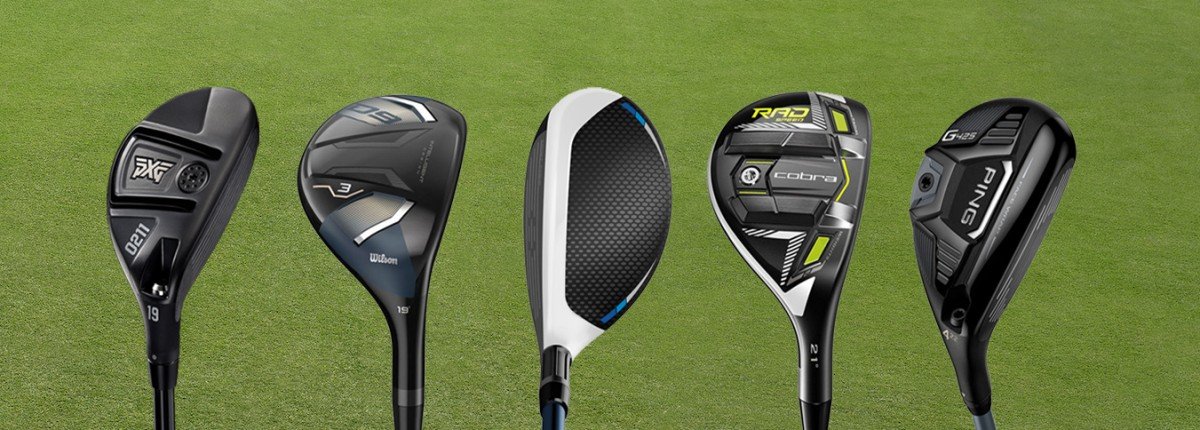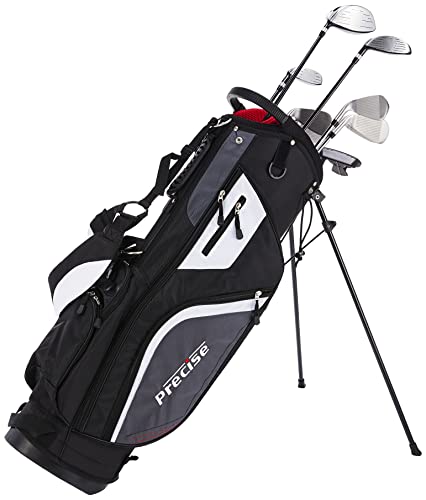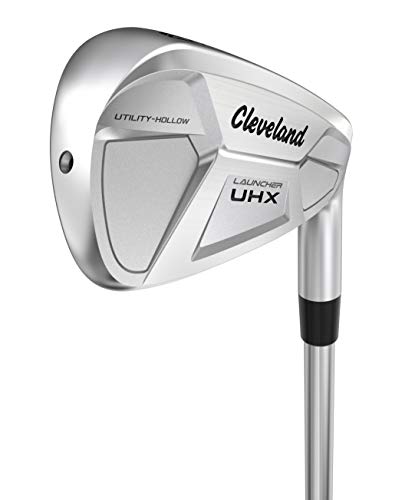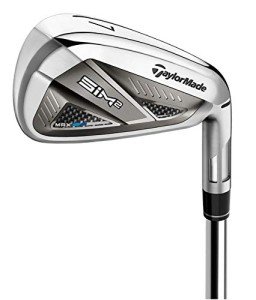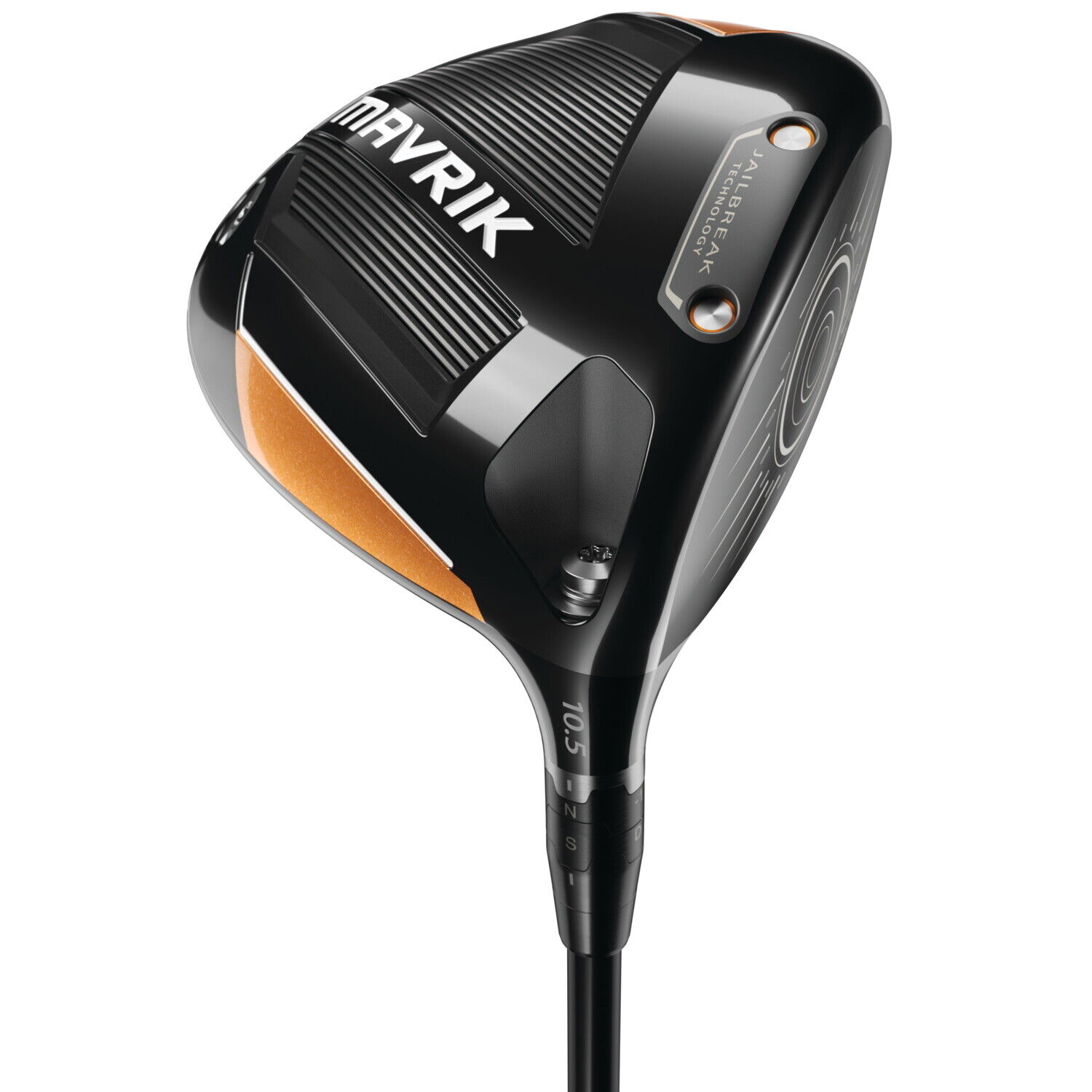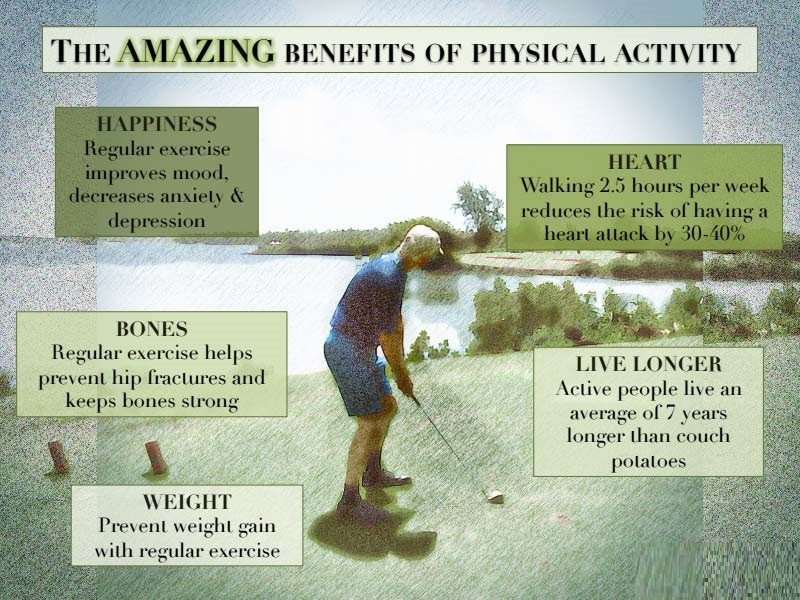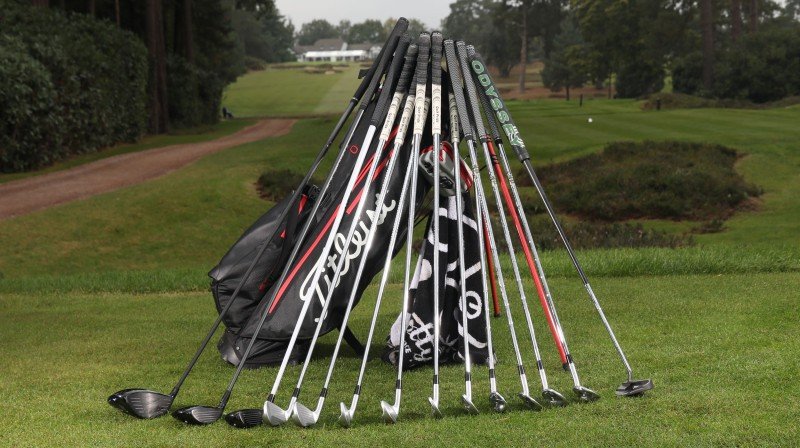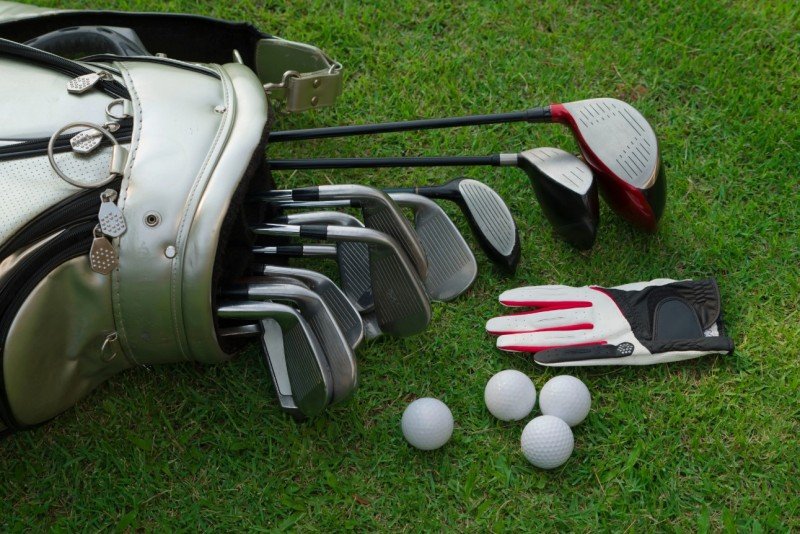In the game of golf, having the right clubs can make all the difference when it comes to hitting a great shot. The key to any golf bag is finding the best and most versatile golf clubs that suit your style of play. Whether you’re a novice golfer or a low handicapper, there are certain clubs that are essential for any round of golf. In this article, we will discuss the best and most versatile golf clubs that you can find and add to your bag.
M5 Complete Men's Golf Club Set - Multiple Sizes
Everything You Need to Elevate Your Game: M5 Complete Men's Golf Club Sets in Multiple Sizes
Product information
€336.96
Product Review Score
4.15 out of 5 stars
202 reviewsProduct links
Types of Golf Clubs
Golf clubs come in many shapes and sizes, each with their own purpose. The different types of golf clubs are the driver, fairway woods, irons, hybrids, wedges, and putters. Here is a brief overview of each club type.
Driver
A driver is a long-shafted club designed for maximum distance off the tee and reaching par 4s in one shot. It has the lowest loft and the longest shaft of all the clubs in your bag allowing for more height and accuracy when striking the ball. Drivers typically have the largest head of all the clubs.
Fairway Woods
Fairway woods are designed for longer shots than irons but with more accuracy. They are most commonly used on the fairway but can be used off the tee as well. They also have a higher loft than a driver but still lower than other clubs.
Irons
Irons are designed to provide less trajectory on shots than a driver or fairway woods while still providing accuracy. Irons are typically used to hit shots that require more control such as when approaching the green. Irons come in several categories such as long irons, mid irons, and short irons.
Hybrids
Hybrids are a relatively new type of club designed to provide the distance of a fairway wood with the accuracy of an iron. Hybrids can be used off the tee, off the fairway, and in place of a long iron. They also come in several variations.
Wedges
Wedges are higher-lofted clubs that are used in short-distance shots such as those around the green. Wedges typically come in three variations: a pitching wedge, sand wedge, and lob wedge. The shape and the design of most wedges provide fantastic accuracy for close-range shots.
Putters
Putters are designed for putting and other short-distance shots around the green. Putters typically have a flat club head with less loft and a perimeter weighted head designed to provide accuracy and a good feel when striking the ball. Putters also come in many variations with different weights, sizes, materials, and design.
a. Woods
Woods are the longest clubs in your bag, also known as a Driver, Fairway Woods and Rescue Woods. They are usually made of metal and have large heads, a slim shaft and shallow faces. They are designed to help you hit long-distance shots and get more curve or lift on your shots. The Driver is the most commonly used wood and it is used mainly to get the ball onto the fairway. It has a long shaft and the head is open to allow a higher launch angle. Fairway woods and Rescue woods are usually used when you are a bit further away from the green and need to hit with more accuracy. Fairway Woods have shallower faces that help you hit the ball with more spin and accuracy. Rescue Woods have a shallower club face than the Driver, but not as shallow as a Fairway Wood, and they are very useful when you need to hit from tight lies on the fairway.
b. Irons
Irons are the most important club on the golf course — if you want to lower your score, you need a solid set of irons. Irons come in a wide array of shapes and sizes, and are often tailored to fit players of different ages and skill levels. There are three main types of irons: cavity-back, blade and game-improvement. Cavity-back irons feature a hollowed-out area on the back of the club head, which helps you achieve maximum trajectory, accuracy and forgiveness. Blade irons are the traditional style, favored by more experienced players. Game-improvement irons are the most forgiving and are the best choice for beginning golfers.
Selecting the right irons can help you hit more greens and birdies, two of the most important aspects of cutting strokes from your game. As you practice and become a better player, you may want to consider upgrading your irons to get more out of your shots.
c. Wedges
Wedges are what complete the set of golf clubs. An ideal wedge setup consists of the following: pitching wedge (46-49 degrees of loft), an approach wedge (50-54 degrees of loft), a sand wedge (54-58 degrees of loft) and a lob wedge (60-64 degrees of loft). Wedges are used for shots requiring a precise amount of spin, height, and distance that cannot be adequately achieved with an iron. Wedges often have a higher center of gravity than irons, which helps with accuracy and more precise ball flight.
A great set of wedges should have the above-mentioned lofts, be well-balanced, and built with durable material. Additionally, the grind on the face of the club should be chosen based on the type of turf you typically play on. Picking the right wedge will enable you to have more precise and consistent shots around the green.
d. Putters
Putters are typically the most used club in the bag and have advanced greatly over the years. Many advanced putters feature sight alignment lines, non-directional face millings that reduce skidding, longer lengths and lighter shafts, and some of the newest putters feature adjustable weights. The major putter manufacturers are all producing advanced clubs with popular insert materials such as copper, aluminum, urethane, and elastomer. Putters may also come in different shapes, head sizes, and lie angles to suit anyone's needs on the greens.
When selecting a putter, it's important to consider design features that suit your putting stroke as well as shaft length, head shape/style, and suitable feel and feedback. Investing in fitting options or testing various putters on the course or driving range will help you determine which model and features best suit your golf game.
4.17 out of 5 starsCleveland Launcher UHX Iron Set ST R RH
Experience Unmatched Distance and Accuracy with the Cleveland Launcher UHX Iron Set
Product information
Product Review Score
Product links
3. Performance Traits of Golf Clubs
Golf clubs come in a variety of shapes, sizes, and materials to meet the requirements of the golfer’s skill level and style of play. Each type of club offers different performance traits for the golfer to use on the course. Some golfers require very specific performance traits from their golf clubs, while others want a versatile club set to work with.
If you are looking for a set of golf clubs with the best performance traits, then you should talk to a golf professional to determine what best fits your game and skill level. They can suggest the right combination of club heads, shafts, materials, and even grips that will help you reach your best performance. Golfers should also review the latest golf club technologies to see if they offer an improved advantage on the course.
When looking for golf clubs with great performance traits, there are some key factors to consider. The club head design should offer the right amount of forgiveness and control, while the shaft flex should be a good match for swing speed. The material of the clubhead and the weight of the head will also affect the performance and trajectory of the shots. The grip size and material should also be considered to ensure that the ergonomics fit correctly in the hand.
To maximize the performance of your golf clubs and to find the ones that best fit your style of play, knowing the performance traits of golf clubs is essential. Once you know the style of clubs you need, finding the right combination of materials, head size, shaft flex, and grip style will help you improve your game and get the most out of your golf clubs.
a. Loft
Loft is the angle of the clubface relative to the ground. The higher the loft, the higher the trajectory of your shot. If you’re lacking loft, then you’ll encounter difficulties getting the ball on the air and to the targets. The ideal range for loft is anywhere from 15 to 20 degrees.
The higher the loft, the more power you’ll have behind your shots. This also means that you’ll need to put in a bit more effort to stabilize your swing. Higher lofted clubs are best suited for people with a stronger swing who need to cut through the wind and find greater accuracy.
Lower lofted clubs are recommended for those with a slower swing speed. Lower lofts will create a more penetrating ball flight, however, the player is likely to lose distance.
For those who are looking for versatility, a combination of 14, 16, and 18-degree irons are good to experiment with. That way, you can pick the best loft for your particular shot and adjust, as needed.
b. Shaft Flexibility
Golf clubs need to be flexible enough to bend and absorb the energy from your swing to maximize the distance and accuracy of your shots. Finding the right shaft flex for your swing is key for achieving the best performance with your clubs. Generally, lower handicap players will require stiffer flexes, while higher handicap players will need softer flexes. It's also important to note that different shaft manufacturers may have different flex ratings for the same flex.
If you’re unsure of your shaft flex, visit a professional golf store and have your swing analyzed. During this time, the professional can make recommendations on which shaft flex would work best with your game.
c. Ball Trajectory
Playing with the right golf club means understanding how to control your ball's trajectory. When it comes to ball trajectory, drivers and woods provide the longest, most accurate shots. Drivers typically feature large heads with a lower loft angle and increased aero-dynamics to produce a less-looping, more direct shot. Woods tend to be more powerful and straighter, but not as long as drivers. To keep your shots low, use a board iron as it provides a flatter and accurate trajectory.
Depending on the type of club, additional control of your ball's trajectory can be achieved. For instance, while irons typically launch the ball in a high flight, wedges can be used to produce lower and more desirable trajectories. For example, the use of a sand wedge could be helpful in setting up the next shot from hazards.
d. Weight of Clubhead
The weight of clubheads has a big impact when it comes to finding the best and most versatile golf clubs. Understanding how a clubhead's weight affects trajectory and distance is important when considering the right club for you. Generally, a heavier clubhead will result in a lower initial launch and a greater overall distance, while a lighter clubhead will create a higher launch with a shorter distance.
For the average golfer, a clubhead weight between 180 and 255 grams is considered appropriate. The heavier end of that range can work in a player's favor when seeking more control and consistency, while a lighter clubhead can help with generating more distance. Clubheads at the lower end of the spectrum usually have more perimeter weighting and a larger sweet spot than their heavier counterparts.
Choosing the most versatile golf clubs begins with understanding the relationship that weight has to the overall performance of the club. Taking into consideration the type of clubhead desired, whether it is a larger size for Woods or a more narrow head for Irons, is essential to make a smart investment.
4. Factors to Consider When Shopping for Golf Clubs
When shopping for golf clubs, there are some factors that should be taken into consideration. Here are a few of the key criteria to consider when selecting a set of clubs.
Club Construction
Not all golf clubs are made the same. Be sure to look at the construction of the club, such as the material of the head, shaft, and grip. The material of the head, for example, affects the weight of the club, the feel of the shot, and the way the ball launches off the face.
Player’s Skill Level
It’s important to get golf clubs that match your skill level. The best clubs for beginners are different from the best clubs for pros, so keep your skillset in mind when shopping.
Price Range
It’s important to stay within your budget when shopping for golf clubs. Consider whether or not you would like to invest in a top-of-the-line set, or if a more economical set will meet your needs.
Golf Course Conditions
Finally, pay attention to the conditions of the course you typically play on. Differing landscapes and terrain can require different styles and manufacturers of golf clubs to best suit the golfer’s needs.
a. Skill Level
When deciding what golf clubs you need, it is important to consider your skill level. Golf clubs are categorized based on skill level, and if you are an experienced golfer, you may need clubs that are better suited for advanced players. If you are a beginner, it is important to find clubs that are suited for beginners. There are clubs that are designed for all skill levels, so make sure you take the time to find the right ones for you.
Beginner golfers will likely do better with oversized club heads as they are easier to hit, while golfers with medium to advanced difficulty levels may need more refined clubs as they become more familiar with the game. Irons with narrow club head designs and high levels of forgiveness, like cavity-back designs, are better suited for the mid to high handicappers.
b. Budget
When it comes to buying golf clubs, finding great options at a price that suits your budget can be a challenge. However, there are plenty of good quality, versatile golf clubs available at a range of price points. Beginners may want to start with a starter set, typically containing at least 6 to 10 clubs. These starter sets usually cost between $150 - $300.
For golfers looking for more quality and durability in their clubs, or different kinds of clubs, a project or tour level set typically ranges between $400 - $800. If you have the money to invest, there are many high-end sets available, some of which cost over $1000.
The good news is that there is sure to be a set of clubs to suit your budget, no matter where you are on your golfing journey.
c. Type of Course
When selecting golf clubs, the type of course you will be playing on should also be factored into your decision. For example, if you are a beginner playing on a shorter course with shorter fairways, the ideal club for the job would be a beginner set. On the other hand, if you are a competitive player playing on a longer course, you may need more specialized golf clubs such as a driver, fairway woods, hybrids, irons, and wedges.
For beginners, a starter set with a driver, a fairway wood, a hybrid, a few irons, and a putter is usually recommended. Advanced players may want to upgrade their clubs based on their skill level and the courses they typically play on. It is important to note that each type of golf club is designed to perform best on a different type of golf course, so it is important to select the right clubs for your game.
5. Suggested Clubs for Beginners
Golf is a great way to improve your skills and have fun at the same time, whatever your level of play. So, what clubs should a beginner invest in? Here are 5 of the most useful clubs in golf.
- Driver: Start off with a 460cc driver that is adjustable with the loft, lie and face angle. This will allow you to adjust the club to the way that suits your individual swing.
- Fairway woods: A 3-wood fairway wood is a great option for most beginners as it is more forgiving than a driver on mis-hits, but with a larger club head, can still generate plenty of power.
- Hybrids: Hybrids are a great option if you have difficulty hitting longer irons. They have a larger head than irons, and a flatter face, making them easier to hit.
- Irons: Start off with a cavity back set of irons, or at least a 3-4 hybrids that can replace irons in your set. A good blend of irons and hybrids will give you the best of both worlds.
- Wedges: A good set of wedges will give you more control around the green and out of the bunker. A pitching wedge, sand wedge and lob wedge should be enough to cover most shots.
These five clubs are the basic building blocks for most beginner golfers. With these five clubs, you should be able to hit the ball anywhere on the course and start to lower your scores in no time!
6. Suggested Clubs for Intermediates
Intermediate golfers typically don’t need the same level of precision and control as professional players -- but they still could benefit from investing in good quality golf clubs. Some types of clubs that intermediates may consider include:
- Irons: A complete set of irons may include one, two, three, four, five, six, seven, eight, nine and PW with a gap wedge, which will give you plenty of club options to play with. Graphite shafts generally provide the best distance and forgiveness.
- Driver: A good quality driver will give you more distance and accuracy off the tee. Look for a club with a graphite shaft that is light but not too stiff.
- Hybrids: A great intermediate club option to replace long-irons and fairway woods. Try out some different hybrids to find the best length, loft, and shaft flex for your game.
- Utility Wedges: Wedges can come in handy when playing from bunkers. Look for utility wedges with various lofts for maximum benefit.
- Putter: Putters feature various lengths, contours, and weights. Experiment with different putters and puts to find something comfortable for your game.
Above all, find the clubs that “fit” your game. With proper and regular practice, you will soon get used to the clubs and choose the best ones for your skill level.
7. Suggested Clubs for Pros
For golf pros, the choice of golf clubs can make a huge impact on the game. It's important for the golfer to have a variety of clubs in order to best suit his or her individual game. A selection of extra-long drivers, plus fairway and hybrid woods, as well as high-lofted wedges can offer increased accuracy, control and power for the more advanced player. Here are some suggested golf clubs for pros:
- Driver: Callaway X Hot Driver, Taylormade SLDR 460cc Driver
- Fairway woods: Cleveland Launcher 3 Wood, Ping G25 Fairway Wood
- Hybrid woods: Callaway XR Hybrid, Tour Edge Bazooka Hybrid
- Wedges: Mizuno MP T-11 Wedge, Titleist SM4 Wedge
These golf clubs are among the best and most-advanced on the market, and with the right style or combination, they can easily help a pro reach the optimum performance level. Of course, every golfer has different needs and desires when it comes to their clubs, so it's important to do a bit of research to determine which clubs best suit your personal needs.
Founders Club Golf Stand Bag with 14-way top
Carry Your Clubs in Style with the Founders Club Golf Stand Bag
Product information
Product Review Score
4.86 out of 5 stars
48 reviewsProduct links
8. Benefits of Owning the Most Versatile Clubs
Golf is a game of skill that requires the right equipment. Having the most versatile golf clubs available can be of great benefit to any player. Here are some of the top benefits of owning the most versatile golf clubs:
- Versatility: The versatility of a golf club is one of its most important features. Being able to hit a variety of shots from different starting points and stances gives you the ability to adapt and create new shots. Owning a set of the most versatile golf clubs will give you the maximum amount of versatility for playing on different courses and situations.
- More Accurate Shots: Having more versatile golf clubs will allow you to hit more accurate shots. You’ll be able to adjust your clubface to the exact angle and position you need to execute the shot. Even if you’re not a pro golfer, having the ability to hit the ball within a few centimeters will increase your accuracy.
- Cost-Effectiveness: Owning the most versatile golf clubs is a cost-effective way of pandering to your own skill level. Rather than buying one club that would be suited to only one type of shot, you can buy a range of clubs tailored to hitting different types of shot. As your skill level improves, you’ll have the option of buying better clubs to expand your range.
- Helps Lower Handicap: Having more versatile clubs can help improve your game and lower your handicap. Being able to hit different types of shots and make adjustments will allow you to hit more shots closer to the target, which can reduce the number of strokes taken.
Having the most versatile golf clubs available is an important element to improving your game. It will allow you to hit a variety of shots, make more accurate shots, and lower your handicap. Ultimately, this is the best way to get the most enjoyment out of your time on the course.
9. Conclusion
In conclusion, the best and most versatile golf clubs for you will depend largely on your needs and preferences. The clubs that are rated highest are those that offer the most features, such as adjustable loft, adjustable weights and adjustable sole plates, to accommodate the changing conditions of the course.
However, some clubs may be rated higher than others for particular features and characteristics. For example, a driver with a more forgiving faceplate may be preferred over another with less forgiveness. Ultimately, the best clubs for you will be those that match your swing and style of play.
You should also consider your budget and purchase clubs that are within your price range. Remember, golf clubs do not always have to be expensive to be of excellent quality.
